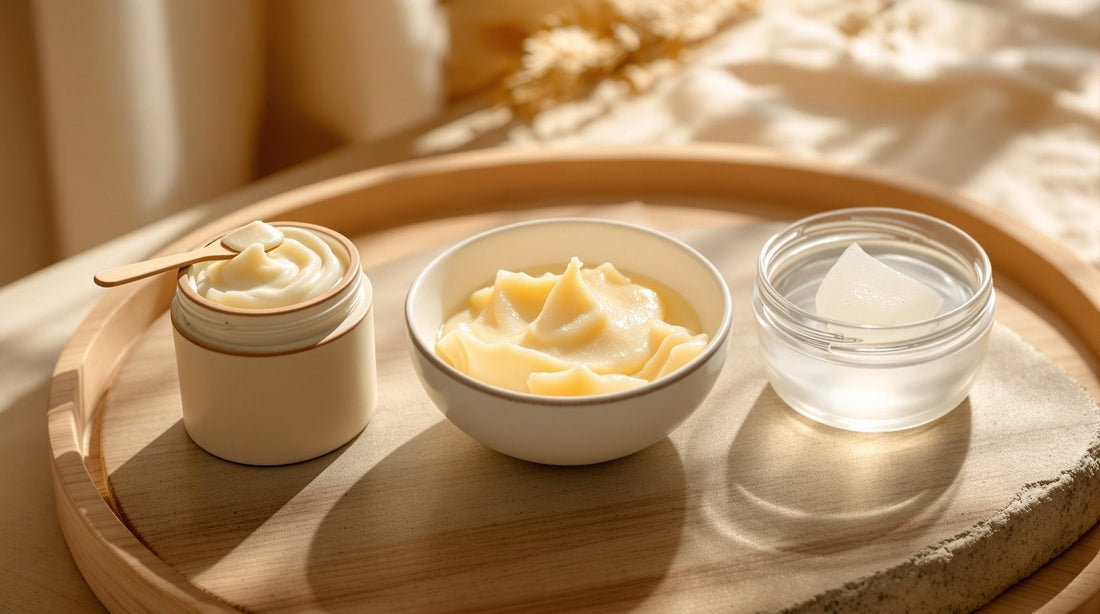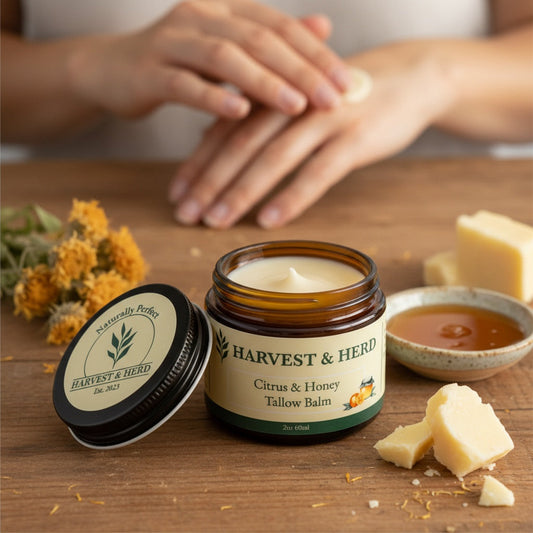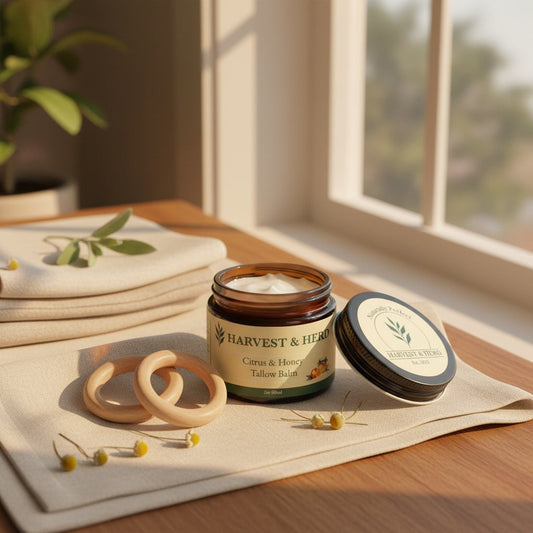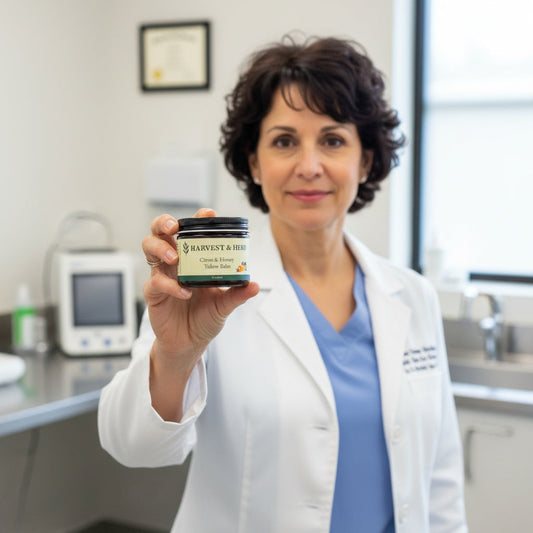
Tallow vs. Shea vs. Petrolatum: The Truth About Occlusives
Share
The Problem with Most Moisturizer Advice
Here's what the skincare industry won't tell you: most moisturizers are playing defense, not offense. They sit on your skin, create a temporary barrier, and call it a day. But what if your moisturizer could actually work with your skin's natural processes instead of just covering them up?
We're about to examine three heavyweight occlusives—tallow, shea butter, and petrolatum—through the lens of actual research, not marketing fluff. Because when you understand the science, the choice becomes remarkably clear.
Understanding Occlusives: Your Skin's Security System
Think of occlusives as your skin's protective seal. They form a barrier that locks in moisture and prevents what scientists call transepidermal water loss (TEWL)—essentially, water escaping through your skin. This isn't just about comfort; it's about skin health at the cellular level.
But here's where it gets interesting: not all occlusives are created equal. Some just block water loss. Others deliver nutrients, fight inflammation, and actually help your skin repair itself. The difference matters more than most brands want you to know.
Tallow: When Nature Gets the Formula Right
We'll be direct: tallow is having a moment, and for good reason. A comprehensive 2024 study published in Cureus confirmed what traditional skincare has understood for centuries—tallow isn't just compatible with human skin; it's remarkably similar to it1.
The research revealed something fascinating: tallow's fatty acid profile (palmitic, stearic, and oleic acids) mirrors human sebum so closely that your skin recognizes it as familiar. The study concluded that tallow is "an effective barrier repair product, helping to reinforce the skin's armor, trap moisture, and soften the skin."
Why This Matters for Your Skin
Unlike synthetic alternatives that simply sit on top of your skin, tallow delivers fat-soluble vitamins A, D, E, and K directly where they're needed. These aren't marketing buzzwords—they're essential nutrients that support cellular repair, collagen production, and antioxidant protection.
Best suited for: Dry, mature, or sensitive skin that needs more than surface-level moisture. If your skin has trust issues with most products, tallow's biocompatibility might be exactly what you've been missing.
"The difference between tallow and synthetic occlusives is like the difference between feeding your skin a nutritious meal versus putting a band-aid on it. Both have their place, but only one actually nourishes."
Shea Butter: The Anti-Inflammatory Powerhouse
Shea butter brings something unique to the table: clinically proven anti-inflammatory benefits that go beyond simple moisturizing. A landmark study in the Hong Kong Medical Journal followed children with eczema and found that 74% of patients reported "very good" or "good" results with shea butter formulations2.
But here's the detail that matters: shea butter doesn't just moisturize—it actively calms inflammation. The study showed skin treated with shea butter completely recovered from water loss within two hours, outperforming mineral oil. That's not moisturizing; that's healing.
The Science Behind the Soothing
Shea butter contains compounds called unsaponifiables—triterpenes, tocopherols, and phenols—that actively reduce inflammation and provide antioxidant protection. While other occlusives create a barrier, shea butter is actively working to calm your skin's inflammatory response.
Best suited for: Inflamed, reactive skin conditions like eczema or dermatitis. If redness and irritation are your primary concerns, shea butter's anti-inflammatory properties make it a smart choice.
Petrolatum: The Synthetic Standard's Hidden Complexity
Let's address the elephant in the room: petrolatum (think Vaseline) has been dermatology's go-to for decades. And recent research from the Journal of Allergy and Clinical Immunology revealed something surprising—it's not the "inert" substance everyone thought3.
The 2016 study found that petrolatum reduces water loss by over 98%—the highest of any occlusive. But more surprisingly, it actively stimulates the skin to produce antimicrobial peptides and barrier repair proteins. That's more sophisticated than expected from a petroleum derivative.
The Trade-offs Nobody Talks About
Here's what petrolatum doesn't do: deliver vitamins, provide antioxidants, or offer any nutritional benefit to your skin. It's incredibly effective at creating a barrier, but that's where the benefits end. Think of it as the duct tape of skincare—incredibly effective for emergency repairs, but not something you'd choose for long-term skin health.
Best suited for: Severely compromised skin barriers or post-procedure care where maximum occlusion is the only priority. For everyday use? There are better options.
The Direct Comparison: What the Research Actually Shows
We compiled the research data into a clear comparison. No marketing spin, just facts:
- Moisture retention: Petrolatum (98%) > Tallow (80-90%) = Shea Butter (80-90%)
- Biocompatibility with skin: Tallow > Shea Butter > Petrolatum
- Anti-inflammatory benefits: Shea Butter > Tallow > Petrolatum
- Nutritional delivery: Tallow = Shea Butter > Petrolatum (none)
- Long-term skin health support: Tallow > Shea Butter > Petrolatum
"Most brands won't show you this comparison because they're invested in one ingredient. We're invested in what actually works for your skin."
Making the Right Choice for Your Skin Type
Let's cut through the confusion with practical guidance:
Choose Tallow If:
- Your skin craves deep nourishment, not just surface moisture
- You have sensitive or reactive skin that rejects most products
- You want an occlusive that delivers vitamins and supports long-term skin health
- You prefer minimally processed, natural ingredients that your skin recognizes
Choose Shea Butter If:
- You prefer plant-based ingredients
Choose Petrolatum If:
- Maximum water retention is your only priority
- You're treating post-procedure skin under medical guidance
- Cost is your primary concern
Why Natural Occlusives Deserve Your Attention
Here's what the research makes clear: while petrolatum offers maximum occlusion, natural alternatives like tallow and shea butter provide something more valuable—multifaceted skin support that goes beyond simple barrier function.
Tallow, in particular, stands out for its remarkable similarity to human skin lipids. When you apply a quality tallow-based product, you're not just moisturizing; you're giving your skin exactly what it needs to repair and maintain itself. Add carefully selected essential oils—like the sandalwood, frankincense, and citrus oils we chose for their specific benefits—and you have a product that works with your skin, not just on it.
The difference is in the details: proper rendering techniques that preserve nutrients, thoughtful formulation that enhances rather than masks tallow's benefits, and a commitment to quality that most brands simply won't match. Because shortcuts might save time, but they don't create the best products. We took no shortcuts with our Citrus & Honey Tallow Balm.
The Bottom Line
Your skin deserves more than a one-size-fits-all solution. While petrolatum has its place in emergency skin repair, the evidence strongly supports natural occlusives for everyday skin health. Tallow offers unmatched biocompatibility and nutritional support. Shea butter provides somed anti-inflammatory benefits. Both deliver results that go beyond simple moisturizing.
The question isn't whether natural occlusives work—the research is clear on that. The question is whether you're ready to give your skin what it actually needs, rather than what's simply convenient.
Because at the end of the day, effective skincare isn't about following trends or choosing the cheapest option. It's about understanding what your skin needs and choosing ingredients that deliver. No shortcuts. No compromises. Just results you can feel.
References
1. Russell, M. F., Sandhu, M., Vail, M., Haran, C., Batool, U., & Leo, J. (2024). Tallow, rendered animal fat, and its biocompatibility with skin: A scoping review. Cureus, 16(5), e60981. https://doi.org/10.7759/cureus.60981
2. Hon, K. L., Tsang, Y. C., Pong, N. H., Lee, V. W., Luk, N. M., Chow, C. M., & Leung, T. F. (2015). Patient acceptability, efficacy, and skin biophysiology of a cream and cleanser containing lipid complex with shea butter extract versus a ceramide product for eczema. Hong Kong Medical Journal, 21(5), 417-425. https://doi.org/10.12809/hkmj144472
3. Czarnowicki, T., Malajian, D., Khattri, S., et al. (2016). Petrolatum: Barrier repair and antimicrobial responses underlying this "inert" moisturizer. Journal of Allergy and Clinical Immunology, 137(4), 1091-1102.e7. https://doi.org/10.1016/j.jaci.2015.08.013



